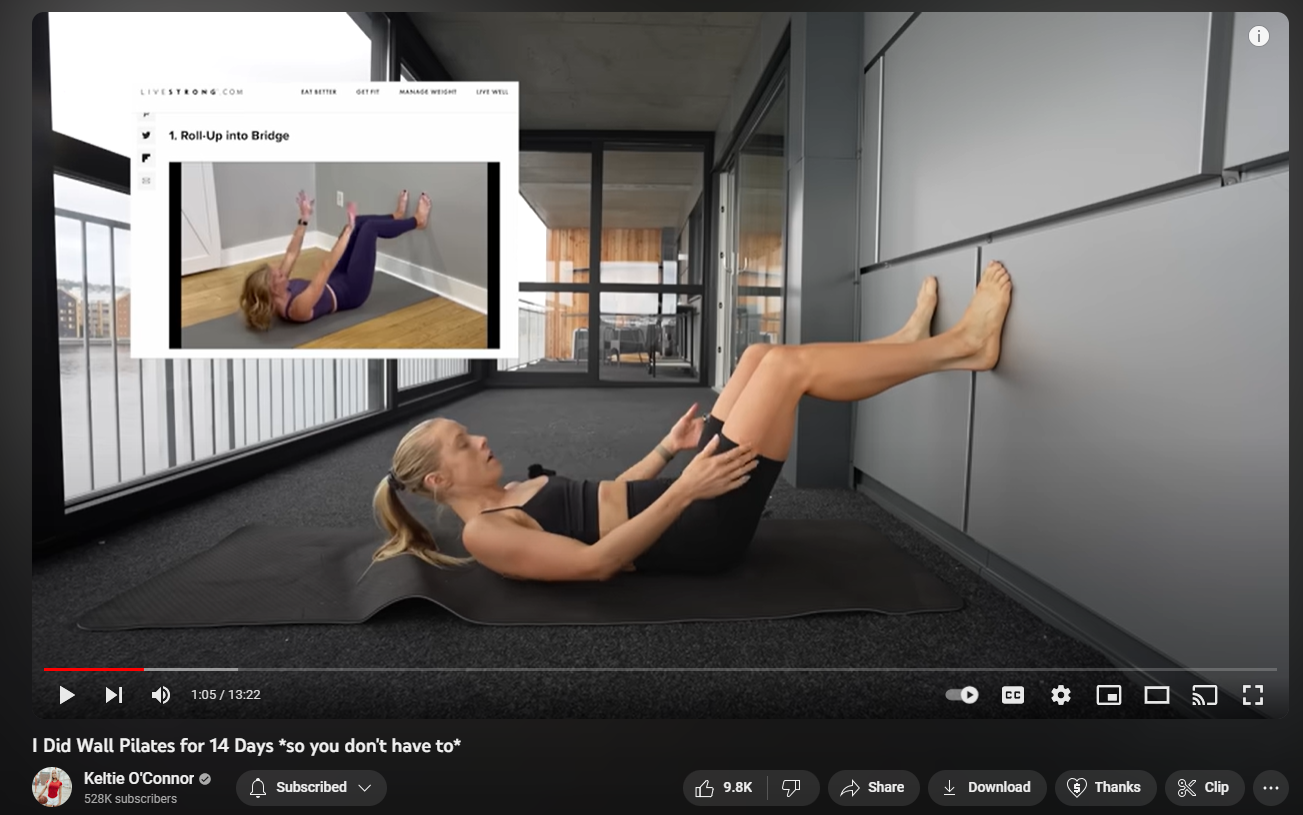Wall Pilates: Another useless 'exercise' targeted at women.
Wall Pilates? A fitness trend that provides minimal-to-no fitness benefits.

A brief introduction to Pilates
'Pilates' is a bit of a wellness buzz-word and has boomed across social media for it's low impact and it's apparent muscular strength benefits[1]. Pilates was originally coined by the German man, Joseph Pilates in 1940, in which Pilates originally utilised springs and other equipment (e.g., a reformer) to either generate resistance or assist with reducing difficulty for injured/impaired active muscles [2]. This recent resurgence of Pilates-love isn't a new phenomena either - we saw also Pilates in the 70-80's gain popularity where it was used in different sports to prevent injury and supplement a conditioning regime.

The 21st century has seen the evolution of Pilates diverge into a couple different formats each with their own general focus: antenatal Pilates, mat Pilates, reformer Pilates, and rehabilitative/clinical Pilates to name a few. Most published scientific studies acknowledge how incredibly effective in rehabilitation of musculoskeletal pathologies, for example, lower back pain and muscle injuries, and for the antenatal population to assist in all things birth [2]. However, the actual scientific evidence for Pilates a main form of 'exercise' for the average, healthy person is poor and suggests minimal improvements in body composition, muscular strength and endurance, and aerobic fitness[2].
So Pilates is excellent for rehabilitating an injury or musculoskeletal pain, if you want to supplement your regular workout routine, or even if you're coming back to exercise after some time off and want to start lightly. I would not recommend Pilates to a relatively fit and/or healthy person who is looking to improve either muscular strength, muscular endurance, muscular hypertrophy, body composition, or aerobic fitness. Personally, I think people can get sucked into the "it burns, therefore is good" attitude with Pilates because of the build up of lactic acid after the 20oth repetition of leg raises.
That brings us to Wall Pilates.
That brings us to our main topic: Wall Pilates. For ease, I'm going to refer to Wall Pilates as WP from here in.
Let's just initially assess some of the claims that the WP community graces us with.

Just take this Jenna Collins Fitness video claiming that only 15 minutes of WP will be fat-burning, low impact, and whole body toning. It's had over a million views on YouTube and many of the comments are from women. So let's debunk some of what it is claimed here:
- Fat-burning: This video claims that this workout will help you to burn fat. This is very unlikely as the workout is not actually at a high enough intensity to utilise fat-stores for energy (i.e., fat burning). High intensity workouts are actually the most likely to utilise fat stores when exercising, even then you're body will still not burn that much fat.
- Whole body toning: Toning is a big buzz word in the fitness industry. What we consider 'toning' to be is when you've got a low enough body fat percentage that you can see more muscle definition. This requires months-years of training and exercise to achieve and is probably not going to be easily achieved by following 15 minutes of WP.
- Low impact: I do agree that this will be low impact, and great for beginners. But here, when I say 'beginners' I am referring to people who have very low exercise capacity, i.e., people who are unable to walk 10 metres without getting puffed. The average, reasonably healthy human being who can walk 10 metres without puffing or muscle pain is very unlikely to benefit from this workout. It purely boils down to the workout not being difficult enough for the average person to achieve any benefit as you are not progressively overloading your body.
Let's discuss the internalised misogyny for a moment
We know that the health and beauty world is very female-centric and essentially makes money from women's insecurities. We also know that the fitness-side of things is also very female-centric and is very difficult for women to navigate, but we are hopefully slowly seeing this change for the better.
Regarding WP, there seems to be some objectively gorgeous human beings participating in the trend. Most people on social media who rave about WP are relatively young, are sporting physically "fit" physiques, and are mostly women. Unsurprisingly, women typically gravitate to Pilates because of it's low-sweatiness, social acceptability and rightful claims that it won't make you "bulky" (which we know it doesn't because it has little to no hypertrophic benefit) [2]. This also probably also holds true for WP. Research suggests that women gravitate to Pilates/yoga and traditional cardio because of their self-image and their fear of "becoming bulky" [3]. Research also suggests that women who exercise are more likely to exercise because of their self-image as opposed to men who generally exercise more to keep fit, healthy, and active [3].
Whilst it is excellent that we are getting people into being more physically active and theoretically WP would be a great starting point, it is extremely irritating just how intensely marketed this trend is to women. To be honest, I've not seen a single man attempt a WP workout. The "girl" exercise trends (including WP, hot yoga etc) can be extremely detrimental to the already uphill battle of supporting women to exercise for strength and fitness. It is disappointing to see social media, general media outlets, and the fitness community continuing to market less effective exercise to women.
References:
[1] von Sperling de Souza, & M., Vieira, CB.(2006). Who are the people looking for the Pilates method? Journal of Bodywork and Movement Therapies, 10, 328-334. doi: 10.1016/j.jbmt.2005.10.005. URL: https://inspiredtherapy.com/pdf/Who are the people looking for the Pilates method.pdf
[2] Silva, LL., da Silva, KBM., de Sousa, L., & Rocha, CP. (2022). Is the Pilates method efficient to cause changes in the body composition of healthy individuals? A systematic review. Journal of Bodywork and Movement Therapies, 32, 51-59. doi: 10.1016/j.jbmt.2022.04.005. URL: https://www.bodyworkmovementtherapies.com/article/S1360-8592(22)00069-9/fulltext
[3] Rohloss, A. (2013). Women and Weight Training. Sport Management Undergraduate. URL: https://fisherpub.sjf.edu/sport_undergrad/71/
Acknowledgement to Keltie O'Connor who I first found Wall Pilates though.
Keltie O'Connor's YouTube Channel: https://www.youtube.com/channel/UC9zEqIwv7yPQ8IlzNYpB_Aw
Keltie O'Connor's Wall Pilates Video:
It can be really hard to correctly order your gym exercises for maximum benefit! Generally, we want the heaviest and hardest exercises first, with the more skill-based low/zero load exercises last. #exercise #gymprogram #beginner pic.twitter.com/5TpEnLBwfL
— TheExerscientist (@exerscientistau) July 28, 2023

